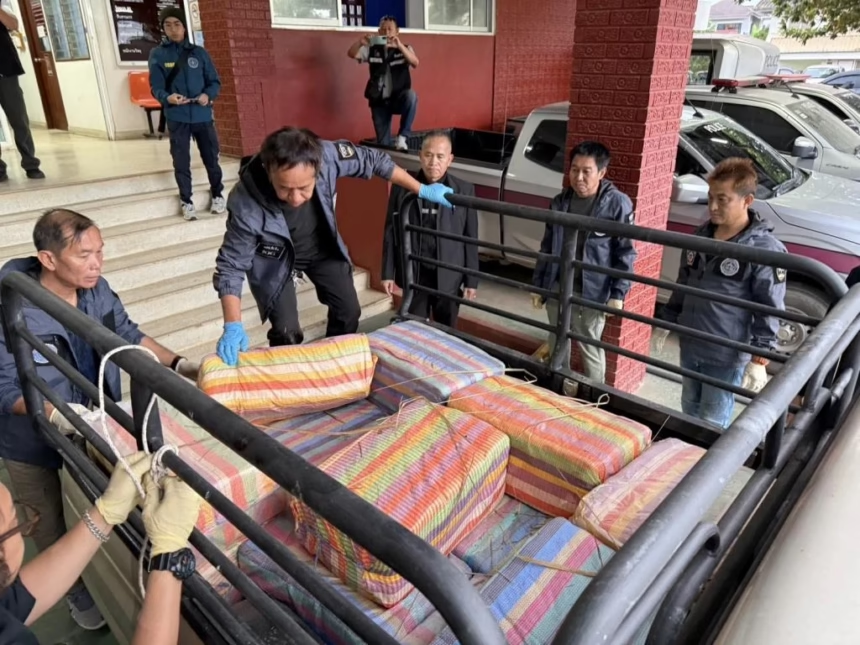CHIANG RAI – Villagers were stunned after spotting a pickup loaded with thatch grass parked all day at the crematorium in Wiang Chiang Rung, Chiang Rai. When police went in to check, they found the truck packed with methamphetamine pills, a total of 24 sacks, estimated at no less than 6,000,000 tablets.
Today, November 14, Pol Maj Gen Manop Senakul, Chiang Rai Provincial Police Commander, instructed officers from the Chiang Rai Provincial Investigation Unit, Region 5 Narcotics Suppression Center, Region 5 Investigation Division, and Wiang Chiang Rung Police Station to inspect a brown Mazda pickup truck.
The truck, with Chiang Rai license plates and a metal frame fitted to the bed, was parked near the crematorium inside the Pong Khian village cremation ground, Moo 8, Dong Mahawan subdistrict, Wiang Chiang Rung district.
On the evening of November 13, officers received a report that this pickup, loaded with thatch grass, had been left inside the cremation ground all day. Locals told police the vehicle did not belong to anyone in the village and looked suspicious because it had been parked there for many hours without anyone coming near it.
Police then set up a stakeout around the area, but saw no one approach the vehicle. By the morning of November 14, when they were sure no one had come to move the truck, they went in to inspect it. Under the pile of thatch grass, they found many large, colorful straw sacks hidden in the truck bed, and more stuffed behind the rear seats. In total, they counted 24 sacks.
Officers opened the sacks and found methamphetamine pills in each one, about 250,000 tablets per sack. Altogether, the haul was around 6,000,000 pills. Police seized the drugs as evidence and began tracing the ownership of the pickup, aiming to track down everyone involved and bring them to justice under the law.
Chiang Rai Provincial Police on High Alert
Chiang Rai Provincial Police have sounded a serious alarm, reporting a sharp rise in drug trafficking that has turned once peaceful forest paths and border hamlets into dangerous hotspots. On 12 November, Pol Maj Gen Manop briefed the media on a series of large seizures that highlight how quickly the situation is getting worse.
Pol Maj Gen Manop explained that officers are now dealing with more cases, larger shipments, and more violent confrontations than in previous years. His briefing on 12 November outlined a series of raids and arrests that paint a clear picture of expansion by drug gangs.
The figures tell the story. From 1 October to 11 November, Region 5 handled 2,919 narcotics cases, including 40 major operations. Seizures of methamphetamine tablets have jumped by 172 percent compared with the same period in 2023. On 9 November, officers at a checkpoint in Lampang stopped a Toyota saloon car carrying 3.5 million yaba tablets destined for the central region, and arrested two suspects.
Just a day later, police raided a warehouse in Chiang Rai and found 10 million pills hidden inside sofas. Five suspects were arrested, including a 40-year-old coordinator named Kritnachai, who is accused of arranging shipments from Myanmar’s Shan State into Thailand.
Earlier in the month, soldiers clashed with armed couriers near Mae Fa Luang, seizing 600,000 tablets after a gunfight that left one suspected smuggler dead. On 2 November, a raid on a luxury house in Chonburi led to the discovery of 3.64 million pills. That consignment was also traced back to networks based in Chiang Rai, reinforcing the view that the province has become a key staging area for drugs moving deeper into the country.
Large volumes of methamphetamine
Authorities say this spike is not random. Since the coup in Myanmar, instability across the border has allowed producers in the Golden Triangle to ramp up manufacturing of synthetic drugs. Large volumes of methamphetamine, in both pill and crystal form, along with a renewed flow of heroin, are slipping through weak points along the frontier.
Criminal groups have adjusted quickly in response to tighter checks at known crossings. They now use drones, modified vehicles, and courier and parcel services to move narcotics, rather than relying only on traditional routes through Laos.
Police have seized cars, motorbikes, houses, and other assets, and found laundered funds exceeding 10 million baht per network. These profits help pay for safe houses, weapons, and security for senior figures in the trade.
The impact on local people is severe. Villages once known for tea fields and hill tribe handicrafts now struggle with addiction, crime, and fear. Many residents worry about late-night raids, gunfire, and the risk of young people being drawn into drug work.
A local Office of the Narcotics Control Board (ONCB) representative said the statistics hide personal stories of families broken apart and futures lost, echoing the nationwide “No Drugs, No Dealers” campaign that targets both supply and demand.
There have been important gains. Joint operations involving the Pha Muang Task Force, the Narcotics Suppression Bureau, and regional police have broken up several major networks and removed drugs worth many billions of baht at the street level. Each success interrupts supply chains and sends a signal to traffickers that authorities are watching.
Pol Maj Gen Manop has promised more intensive patrols, stronger checkpoints, and new X-ray technology to scan vehicles more effectively. Security experts and public health workers, however, argue that arrests and seizures alone are not enough. They call for long-term solutions such as better job opportunities in border areas, closer cooperation with neighbouring countries, and expanded treatment programmes for users to reduce demand.
In Chiang Rai’s green hills, the struggle against narcotics continues day and night. For police, soldiers, and community leaders, the goal is clear: protect families, cut off traffickers, and give border communities a chance to live without the constant threat of drugs and violence.















